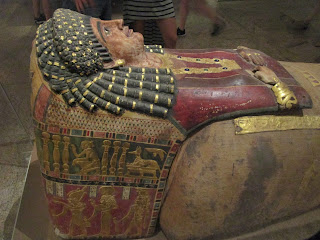 One kind is intentional, made to honor and remember past relatives and preserve them for as long as possible. The Egyptians were known for doing this and then entombing them deep in pyramids that are nothing short of architectural wonders. In our hemisphere, the Inca mummified their royalty in a sitting position and treated them not as honored dead but alive, and sought their advice. They even were known to take them to war with them. This is by no means an exhaustive description of similar practices, its only a small sampling with a couple of examples.
One kind is intentional, made to honor and remember past relatives and preserve them for as long as possible. The Egyptians were known for doing this and then entombing them deep in pyramids that are nothing short of architectural wonders. In our hemisphere, the Inca mummified their royalty in a sitting position and treated them not as honored dead but alive, and sought their advice. They even were known to take them to war with them. This is by no means an exhaustive description of similar practices, its only a small sampling with a couple of examples.The other kind tends to be those that were preserved naturally, such as the Ice Man, an shepherd from ancient times that died in the heights of the mountains and was preserved until he melted out and archeologists found him. Also commonly known are the "bog people," men and women who were buried in layers of peat and found thousands of years later by men digging out peat for fuel. There's a lot of great reading on these guys.
Not all mummies are human though, as the word has come to encompass a greater range of ideas. In the same way as the Ice Man, mammoths frequently thaw out of icebergs in Russia, extremely well preserved and including their organs, hair, and tusks that are harvested in place of those of modern elephants.
We've also stretched out the term in paleontology to include exceptionally preserved fossils, especially those that still have some dimension to them and are at least partially surrounded with impressions or actual skin. It doesn't have to all be preserved, but all sides should have at least some on them. I'm only aware of about half a dozen of these, although I know of one specimen that has the potential to be one. That one hasn't be heavily studied nor published yet, though, so I'll put off being excited about that one and continue being a general skeptic. Regardless, when they do turn out to be the actual thing, they are extremely impressive and provide valuable information about aspects of the creature that we wouldn't otherwise be able to find out. Among other things is information about diet, not from the teeth but from, sometimes, actual stomach contents. With careful preparation, chemistry, and observation, pair with new tests coming into science, we learn more from these every time they are looked at.
 Perhaps just because of how common the fossils are found, generally these are hadrosaurs, or the duck-billed dinosaurs. For some reason that we're really only beginning to figure out, their skin just preserves very well to begin with. I'm working on one at my museum back home currently that may provide some really interesting information, so this is very close to me. I love the preservation of these; it allows us to talk about how the animal lived and died, its ecology, its responses to its environment, and everything that makes animals.... well, animals.
Perhaps just because of how common the fossils are found, generally these are hadrosaurs, or the duck-billed dinosaurs. For some reason that we're really only beginning to figure out, their skin just preserves very well to begin with. I'm working on one at my museum back home currently that may provide some really interesting information, so this is very close to me. I love the preservation of these; it allows us to talk about how the animal lived and died, its ecology, its responses to its environment, and everything that makes animals.... well, animals.If you decide you're super interested, because this really cool, there's a good book on dinosaur mummies called Grave Secrets of Dinosaurs: Soft Tissue and Hard Science. It was one of the first books I read on paleontology after all of the many picture books and "field guides" on dinosaurs. Its a great read.
By the way, the picture is of one of these awesome hadrosaurs that is at the American Museum of Natural History. This one actually looks like what you would think of as a mummy!!
No comments:
Post a Comment